Bosch D1260, D7212GV3-C1260, D1260B, D1260BLK, D1260R User Manual
...
D1260/D1260B
Owner's Manual
EN Keypad

D1260/D1260B | Owner's Manual
This system includes a telephone line seizure feature. The system may be programmed to communicate with a central monitoring station to report system events. You will not be able to use your phone while the system is communicating with the central monitoring station. In the unlikely event that the central station is not able to receive the report, your phone may be unavailable for up to 20 minutes while the panel makes additional communication attempts.
Some commands listed below may not be available. Contact your security company for more information.
Contents
Introduction .................................................. |
5 |
Your Keypad......................................................... |
5 |
About This Owner’s Manual................................. |
6 |
Part I: Security system basics ........................ |
7 |
Using the keypad ................................................. |
7 |
Command center keys ......................................... |
7 |
Points ................................................................. |
8 |
What is a Point?................................................... |
8 |
Controlled Points ................................................ |
8 |
24-Hour Points..................................................... |
8 |
Your Custom Display ........................................... |
8 |
View Faulted or Bypassed Points ........................ |
9 |
To automatically scroll faulted or bypassed points
.................................................................9
Warning Displays and Tones.............................. |
10 |
Keypad Quiets for Keystrokes ........................... |
10 |
Priority of Events ............................................... |
10 |
Fire Alarms......................................................... |
11 |
Silencing Fire Alarms ......................................... |
11 |
Burglary Alarms.................................................. |
12 |
Silencing Burglary Alarms.................................. |
12 |
Fire Trouble and Fire Supervisory Events.......... |
13 |
Silencing Fire Trouble and Fire Supervisory |
|
conditions.......................................................... |
13 |
Special Fire Trouble and Fire Supervisory Display |
|
13 |
|
Viewing Fire Trouble and Fire Supervisory |
|
conditions.......................................................... |
13 |
Non-Fire Trouble and Supervisory Events ......... |
13 |
Silencing Non-Fire Trouble and Supervisory |
|
Events ............................................................... |
13 |
Special System Trouble Display ........................ |
14 |
Cleared Events Are Not Lost ............................. |
14 |
Entry Delay Tone and Display............................ |
14 |
Exit Delay Tone and Display .............................. |
14 |
Keystroke Checking Tones ................................ |
14 |
Silencing an Alarm............................................. |
14 |
To SILENCE an alarm: ....................................... |
14 |
How Your System Reports Alarms..................... |
15 |
Part II: System Commands ........................... |
16 |
Entering a Passcode.......................................... |
17 |
Turning On the System (Arming) ...................... |
17 |
To Turn Your Security System On (Arm): .......... |
17 |
Turning Off the System (Disarming) ................. |
17 |
To Turn Your Security System Off (Disarm):..... |
18 |
Turning On the System (Arming) With a Duress |
|
Passcode ........................................................... |
18 |
Turning On the System (Arming) With Doors or |
|
Windows Open.................................................. |
18 |
MASTER ARM ? (COMMAND + 1) ...................... |
20 |
Description........................................................ |
20 |
Using Master Arm: ............................................. |
20 |
Master Arming all Areas .................................... |
20 |
MASTER ARM INST ? (COMMAND + 1 + 1) ....... |
22 |
PERIMETR INST (COMMAND + 2) ..................... |
23 |
Turn On the Perimeter With No Delays ............. |
23 |
Using Perimeter Inst: ........................................ |
23 |
PERIMETR DELAY ? (COMMAND + 3)................ |
24 |
Turn On the Perimeter With Delays .................. |
24 |
Silence the Trouble Sounder & Clear Trouble |
|
Display (COMMAND + 4)................................... |
24 |
Description........................................................ |
24 |
Using COMMAND 4: .......................................... |
24 |
VIEW MEMORY ? (COMMAND + 4 + 0).............. |
25 |
View Event Memory........................................... |
25 |
Using View Memory:.......................................... |
25 |
2 |
Bosch Security Systems | 12/15 | F01U036089-04 |

D1260/D1260B | Owner's Manual | Contents
WALK TEST ? (COMMAND + 4 + 4).................... |
26 |
Walk Test ........................................................... |
26 |
RESET SENSORS ? (COMMAND + 4 + 7)........... |
27 |
Reset Sensors.................................................... |
27 |
Using Reset Sensors:......................................... |
28 |
WATCH MODE ? (COMMAND + 6) ..................... |
29 |
Watch Mode....................................................... |
29 |
Entering Watch Mode: ....................................... |
29 |
Exiting Watch Mode:.......................................... |
29 |
PERIMETR PART ? (COMMAND + 8) .................. |
31 |
Partially Turn On the Perimeter......................... |
31 |
Using Perimetr Part: .......................................... |
31 |
Special Alerts (COMMAND + 7 and COMMAND + |
|
9) ............................................................... |
32 |
Using COMMAND 7:........................................... |
32 |
Using COMMAND 9:........................................... |
32 |
Part III: Advanced Commands ...................... |
34 |
Advanced Commands ........................................ |
34 |
Terms Used in This Section ............................... |
34 |
BYPASS A POINT? (COMMAND + 0) ................. |
36 |
Description ........................................................ |
36 |
Using Bypass a Point ......................................... |
36 |
UNBYPASS A POINT? (COMMAND + 0 + 0) ....... |
38 |
Description ........................................................ |
38 |
Using Unbypass a Point: .................................... |
38 |
SEND REPORT ? (COMMAND + 4+1 or 4+2) ..... |
40 |
Description ........................................................ |
40 |
Using Send Report............................................. |
40 |
REMOTE PROGRAM ? (COMMAND + 4 + 3) ...... |
41 |
Description ........................................................ |
41 |
For systems without a phone number ............... |
41 |
For systems with a phone number or network |
|
connection......................................................... |
42 |
CHANGE TIME/DATE (COMMAND + 4 + 5) ........ |
44 |
DOOR CONTROL (COMMAND + 4 + 6).............. |
45 |
Description ........................................................ |
45 |
Using Door Control............................................ |
45 |
Access Level ...................................................... |
47 |
CHANGE DISPLAY (COMMAND + 4 + 9) ............ |
48 |
Brighten/Dim Display ........................................ |
48 |
Show Continuous Time/Date............................. |
48 |
EXTEND CLOSING (COMMAND + 5 + 1)............ |
49 |
CHG SKEDS ? (COMMAND + 5 + 2)................... |
51 |
Description........................................................ |
51 |
Using Chg SKEDS .............................................. |
51 |
DEL USER ? (COMMAND + 5 + 3) ..................... |
54 |
CHG RELAYS ? (COMMAND + 5 + 4) ................. |
55 |
CHG PASSCODES ? (COMMAND + 5 + 5)......... |
56 |
Description........................................................ |
56 |
Using Chg Passcodes ........................................ |
56 |
ADD/CHANGE USER (COMMAND + 5 + 6) ........ |
57 |
DEFAULT TEXT ? (COMMAND + 5 + 7) .............. |
65 |
FIRE TEST ? (COMMAND + 5 + 8) ..................... |
66 |
DISPLAY REV ? (COMMAND + 5 + 9)................. |
68 |
SERVICE MENU ? (9 + 9 + Enter) ...................... |
68 |
Using View Log.................................................. |
69 |
Using Print Log.................................................. |
70 |
Using Display Rev .............................................. |
71 |
Using Service Walk Test .................................... |
71 |
Using Default Text............................................. |
72 |
Using Setup....................................................... |
72 |
Part IV: Multi-Area Use ................................. |
74 |
Working with Multiple Areas from a Single |
|
Command Center .............................................. |
74 |
View Area Status ............................................... |
75 |
View Point Status .............................................. |
75 |
MOVE TO AREA ? (COMMAND + 5 + 0) ............. |
76 |
Turning On the System ..................................... |
77 |
Turning on Selected Areas ................................ |
77 |
Turning on Multiple Areas with a Passcode ...... |
78 |
Faulted Points in Other Areas ........................... |
78 |
Turn On the Entire System Without Delays....... |
79 |
Turning on All or Selected Areas....................... |
79 |
Turning Off the System ..................................... |
80 |
Turning Off Multiple Areas with a Passcode ..... |
80 |
Turning Off Multiple Areas with Disarm All ....... |
80 |
Turning Off Selected Areas ............................... |
81 |
Appendix ..................................................... |
83 |
Supplementary Information for Adding Passcodes |
|
.............................................................. |
83 |
User Authority Levels ........................................ |
83 |
Passcode Worksheet......................................... |
83 |
User Interface.................................................... |
83 |
User Interface.................................................... |
85 |
User (Passcode) Worksheet (User 000 to 038) 86 |
|
Bosch Security Systems | 12/15 | F01U036089-04 |
3 |

D1260/D1260B | Owner's Manual Contents
♦ User (Token) Worksheet (User 000 to 038) |
Figure 6: Escape Route ................................ |
103 |
D9412x/D7412x Only ........................................ |
87 |
|
User (Passcode) Worksheet (User 039 to 075).88 |
|
♦ User (Token) Worksheet (User 039 to 075) |
|
D9412x/D7412x Only ........................................ |
89 |
User (Passcode) Worksheet (User 076 to 114) |
|
(101-249 = D9412x only) ................................... |
90 |
♦ User (Token) Worksheet (User 076 to 114) |
|
D9412x/D7412x Only (101-249 = D9412x only) 91 |
|
User (Passcode) Worksheet (User 115 to 150) |
|
(101-249 = D9412x only) ................................... |
92 |
User (Token) Worksheet (User 115 to 150) (101- |
|
249 = D9412x only) ........................................... |
93 |
User (Passcode) Worksheet (User 151 to 189) |
|
(101-249 = D9412x only) ................................... |
94 |
User (Token) Worksheet (User 151 to 189) (101- |
|
249 = D9412x only) ........................................... |
95 |
User (Passcode) Worksheet (User 190 to 226) |
|
(101-249 = D9412x only) ................................... |
96 |
♦ User (Token) Worksheet (User 190 to 226) |
|
D9412x/D7412x Only (101-249 = D9412x only) 97 |
|
User (Passcode) Worksheet (User 227 to 249) |
|
(101-249 = D9412x only) ................................... |
98 |
User (Token) Worksheet (User 227 to 249) (101- |
|
249 = D9412x only) ........................................... |
99 |
User (Passcode) Worksheet (Blank) ............... |
100 |
User (Token) Worksheet (Blank) ..................... |
101 |
Security System Limitations............................ |
101 |
Fire Safety and Evacuation .............................. |
102 |
Standard Displays............................................ |
103 |
System Trouble Displays ................................. |
104 |
Security System Glossary ................................ |
106 |
Maintenance and Service ................................ |
107 |
How to Clean the Command Center................ |
107 |
Your Alarm Company ....................................... |
107 |
Tables |
|
|
Table 1: D1260/D1260B Keypad keys |
............. 7 |
|
Table 2: |
Keypad Commands ......................... |
16 |
Table 3: |
Door Status ..................................... |
46 |
Table 4: |
Sked Table ...................................... |
53 |
Table 5: Screen Area Definitions .................. |
76 |
|
Figures
Figure 1: D1260/D1260B front panels ............. |
5 |
Figure 2: D1260/D1260B Digital Keypad.......... |
6 |
Figure 3: Using soft keys for display menus ..... |
6 |
Figure 4: Smoke Detector Locations (Plan |
|
View).............................................. |
102 |
Figure 5: Smoke Detector Locations (Elevation |
|
View).............................................. |
102 |
|
|
4 |
Bosch Security Systems | 12/15 | F01U036089-04 |
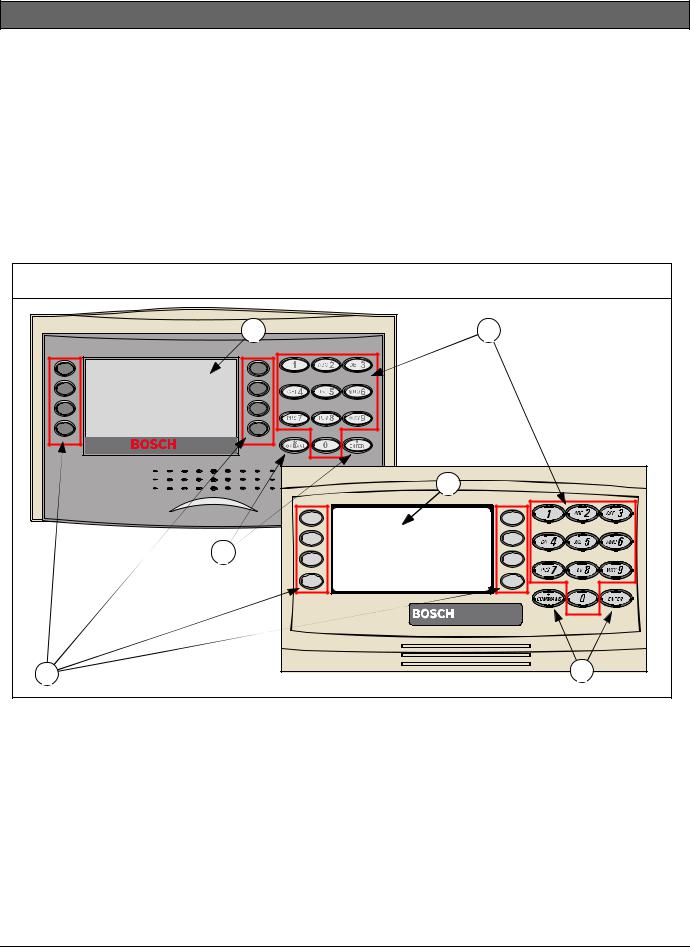
D1260/D1260B | Owner's Manual | Contents
Introduction
Your security system helps to secure life, property, and investments against fire, theft, and bodily harm. The keypad is an advanced digital device that offers a variety of features not available with other systems. Its highly visible, backlit keypad and built-in sounder alert you to a number of system events. A familiar ATM style design and ease-of-use make it ideal for property monitoring.
Your Keypad
Your Keypad is composed of two main sections: the numeric keypad section and the display/selection keys (also referred to as “soft keys”).
Figure 1: D1260/D1260B front panels |
|
|
|
|
|
1 |
|
D1260B |
2 |
|
|
|
|
D1260 |
|
|
|
1 |
|
|
4 |
|
|
|
|
|
|
|
# |
|
3 |
|
|
4 |
1 - |
LCD Display |
3- |
Soft Keys |
|
2 - |
Digital Keypad |
4 - |
Keypad Function Keys |
|
Bosch Security Systems | 12/15 | F01U036089-04 |
5 |
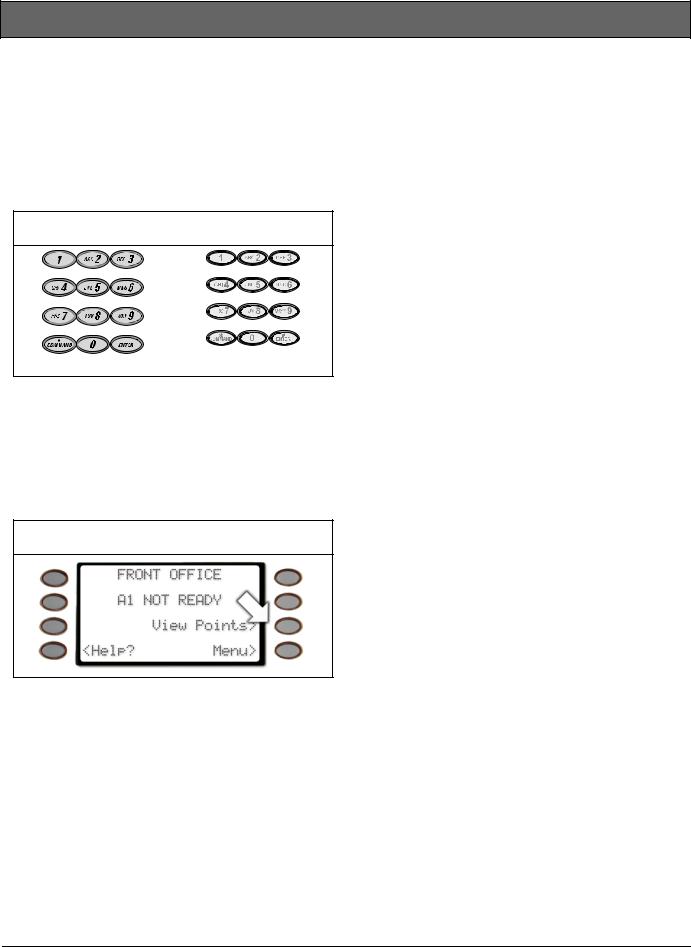
D1260/D1260B | Owner's Manual | Introduction - About This Owner’s Manual
The numeric keypad section is a standard 3x4keypad matrix that should be very familiar to you. It has been designed to closely resemble that of a standard telephone with the numeric keys of 1-0; and * and # keys. The display is an easy-to-read 4 line by 20-character liquid crystal display that becomes backlit when a key is pressed or a system event occurs.
Figure 2: D1260/D1260B Digital Keypad
|
# |
D1260 |
D1260B |
The soft keys are used to make selections when the display shows an arrow pointing next to it. For example, the display shown to the right is what will appear when there are faulted points in your system. Pressing the soft key adjacent to the View Points> display will then begin to scroll the faulted point(s) in your system.
Figure 3: Using soft keys for display menus
About This Owner’s Manual
This owner’s manual is divided into five main sections:
•Security System Basics: Covers how to use the Keypad, the various keys on the Keypad, what a “Point” is and the various types of Points, and custom displays.
•System Commands: This section covers system commands, such as turning the system on and off, resetting sensors, etc. Your security company programs the functions described in this section. Some of them may not be included in your system. Some of the functions covered may require you to enter your personal passcode.
•Advanced Commands: Allow users to perform advanced system functions like add and delete user passcodes, reassign authority levels to user passcodes and operate or change programmed scheduled events (Skeds) from the keypads. As you make changes to the system, update the information contained in the tables in this guide to provide an accurate account of the programmed information.
•Multi-Area Use: Each of the functions described in the preceding section on Advanced Commands is presented as though your system includes only one area. If your system includes more than one area, it can be set up one of two ways by the installing company: (1) Each keypad will only have access to the local area to which it is assigned, or (2) Each keypad may access either some or all areas beyond the one to which it is assigned.
•Appendix: Covers the limitations of a Security System, Fire Safety and Evacuation, Maintenance and Service of your Security System and How to Clean the Keypad.
6 |
Bosch Security Systems | 12/15 | F01U036089-04 |

D1260/D1260B | Owner's Manual | Part I: Security system basics
Part I: Security system basics
Using the keypad
Your security system provides quick access to functions by pressing the COMMAND key and one or two additional keys.
D1260 D1260B
Another way to access functions is through the Command Menu. To access the Command Menu, press the soft key adjacent to Menu> shown in the display.
Pressing the <Previous or Next> soft key while in the Menu List allows you to scroll up or down through the list of functions programmed by your security company.
Pressing the soft key adjacent to the function being displayed initiates the function.
To exit the Command Menu, press the <Exit soft key.
Use the Command Menu to locate functions you don’t use often or that don’t have a command number.
Command center keys
Table 1: D1260/D1260B Keypad keys
Key |
Name |
D1260 D1260B
COMMAND |
# ENTER
ENTER
EXIT
Previous
Next
Description
Use the COMMAND key in combination with one or two numeric keys to perform a function
The ENTER key is used to complete the entry of your passcode at the command enter. Whenever a function requires that you enter your passcode at the keypad, first press the digits of the code and then press the ENTER key. Your system will not recognize your passcode until you press ENTER.
When Exit> or <Exit appears in the keypad display, pressing the soft key adjacent to it will bring you one level up in the function or will exit you out of the function you are in. These functions may be displayed on either side of the display.
When viewing a list, pressing the <Previous soft key will take you back to the previously shown item.
Press the Next> soft key to pass over the present item(s) in a menu or function.
Bosch Security Systems | 12/15 | F01U036089-04 |
7 |

D1260/D1260B | Owner's Manual | Part I: Security system basics - Points
Points
What is a Point?
A “point” is a detection device, or group of devices connected to your security system. Points display individually at the keypad with custom text. The text can describe a single door, motion sensor, smoke detector, or an area such as UPSTAIRS or GARAGE. There are two basic types of points, controlled and 24-hour.
Fire alarms have a unique audible warning signal.
Non-Fire Points
Non-fire 24-hour points are always armed and cannot be disarmed.
Controlled Points
Controlled points respond to alarm conditions depending upon whether the system is turned on (armed) or turned off (disarmed). Controlled points are programmed to respond instantly to alarm conditions or to provide a delay for you to reach the keypad and disarm the system.
The type of alarm appears before the point text when there is an alarm. There are two types of controlled points, perimeter points and interior points.
Perimeter Points
These points usually include all exterior doors and windows of the building.
Interior Points
These points usually include interior forms of burglary detection devices, such as motion sensors, or inside doors, for example.
24-Hour Points
24-hour points are always on, even when the burglary system is disarmed (turned off). There are two types of 24-hour points, fire points and non-fire points.
Fire Points
Fire points exclusively monitor fire detection devices. They are always armed and cannot be disarmed. You can clearly distinguish fire points from other non-fire points at the keypad.
When there is a fire alarm, the display shows the following:
*FIRE ALARM* is displayed on the first line, text identifying the point as a fire point is displayed on the second line, and instructions for silencing the alarm are displayed on the third and fourth lines.
Your Custom Display
“At an idle state” means that the system is not currently performing a function entered by a user. There are three idle states the system may be in:
•Turned on (Armed)
•Turned off (Disarmed) with no points faulted (doors or windows open) in the area
•Turned off with faulted points (doors or windows open) in the area.
8 |
Bosch Security Systems | 12/15 | F01U036089-04 |

D1260/D1260B | Owner's Manual | Part I: Security system basics - View Faulted or Bypassed Points
This manual uses the default idle state displays for examples of these idle states. Your security company may have programmed custom text for the idle displays in your system. The custom text and the default text for the three system idle displays follow.
|
|
|
Default Text |
Custom Text |
|
Area Name Text |
|
_ _ _ _ _ _ _ _ _ _ _ _ _ _ _ _ |
|
|
Appears on the top line of the |
|
|
|
|
display |
|
|
|
|
|
|
|
|
|
|
|
|
|
Throughout this manual, all examples of “AREA # NAME TEXT” will use “AREA 1 WAREHOUSE.” The actual name of Area 1 will differ depending on the specifics of your system.
|
Area Is On Text |
|
|
|
_ _ _ _ _ _ _ _ _ _ _ _ _ _ _ _ |
|
|
|
|
|
|
|
|
|
|
|
|
|
|
|
|
|
|
|
|
|
|
|
|
|
|
|
|
|
The Silence> soft key is only shown when the keypad buzzer is active
|
|
|
|
|
|
|
|
|
|
|
|
|
|
|
Area Off Text |
|
|
|
_ _ _ _ _ _ _ _ _ _ _ _ _ _ _ _ |
|
|
Indicates the area is turned off |
|
|
|
|
|
|
|
|
|
|
||
|
(disarmed). 24-hour points |
|
|
|
|
|
|
remain armed. |
|
|
|
|
|
|
|
|
|
|
|
|
|
Area Not Ready Text |
|
|
|
_ _ _ _ _ _ _ _ _ _ _ _ _ _ _ _ |
|
|
Indicates that the area is turned |
|
|
|
|
|
|
|
|
|
|
||
|
off, but not ready to arm. |
|
|
|
|
|
|
|
|
|
|
|
|
View Faulted or Bypassed Points
To properly arm your system, all the doors and windows in the system must be in the normal (not faulted) condition. Viewing the faulted points helps you find faulted points and correct them so proper arming is possible.
Your keypad offers two ways of displaying faulted and bypassed point information. The first causes the faulted or bypassed point information to scroll automatically through the display. The second allows you to manually scroll through each individual point description.
To automatically scroll faulted or bypassed points
1.Ensure your keypad shows idle text.
The View Points> soft key may be displayed on the third line of the keypad if there are faulted points.
2.Press any number key. The text for Area 1 is displayed first followed by the number (#) of faulted points on the next line
Bosch Security Systems | 12/15 | F01U036089-04 |
9 |
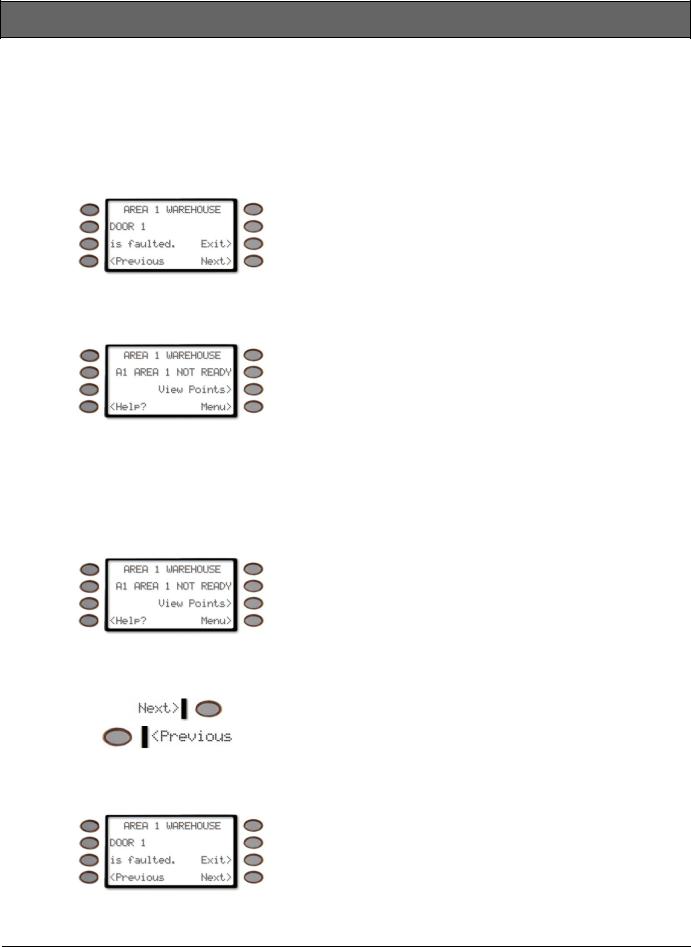
D1260/D1260B | Owner's Manual | Part I: Security system basics - Warning Displays and Tones
3.The display changes to show the point text description of the faulted points. If there is more than one faulted point, the display will automatically cycle through all of them before returning to idle text.
These displays scroll at the rate of 3 seconds each.
4.The display returns to idle text after scrolling through the faulted and bypassed point information.
The View Points> soft key will be shown when there are faulted points.
To manually scroll faulted or bypassed points:
1.Ensure your keypad shows idle text.
2.Press the View Points> soft key to display the first faulted point.
Press the Next> soft key or the <Previous soft key repeatedly to display the faulted and bypassed point information.
If faulted or bypassed points in other areas exist, then the display changes to show these points before returning to idle text.
Warning Displays and Tones
Your keypad emits one of several distinct tones and displays custom text to alert you to system events. Additional bells or sirens may also be connected to your system. Bells or sirens mounted on the exterior of your premises alert neighbors to emergencies and provide an audible guide for police and fire fighters.
Keypad Quiets for Keystrokes
Pressing any key on the keypad lights the keys and quiets any warning tones. If you don’t press another key within 20 seconds, the keypad lights go out and the warning tones resume.
Priority of Events
If more than one event occurs, your system sorts them into one of four groups. The groups (highest priority first) are:
•Fire Alarms
•Burglary Alarms
•Fire Troubles and Fire Supervisory conditions
•Non-Fire Troubles and Non-Fire Supervisory conditions.
The group with the highest priority scrolls first in the keypad’s display. Descriptions of the tones and displays for each group and instructions for silencing the tones are included in the descriptions that follow.
10 |
Bosch Security Systems | 12/15 | F01U036089-04 |

D1260/D1260B | Owner's Manual | Part I: Security system basics - Fire Alarms
Fire Alarms
Fire alarms are the highest priority events. When a fire point activates, your keypad emits a pulsating high-pitched fire tone. Evacuate all occupants and investigate for smoke or fire. Ensure that all occupants know the difference between the burglary tone and the fire tone. The tone sounds for the time set by your security company.
Silencing Fire Alarms
Entering a personal passcode with the proper authority level silences a fire alarm and disarms the system if it was armed.
The system will now display *Alarm Silenced* on the second line and Clear Display> appears on the fourth.
Then the number of points in alarm (# FIRE ALARMS) and then the area text appears (AREA 1 NAME TEXT) followed by the custom text of all the points in alarm (SMOKE DETECTOR), in the order of occurrence.
If there is more than one point causing an alarm, the display will show each point for three seconds before showing the next one.
When the last alarm is shown, the next display is the idle text. The cycle is repeated until COMMAND 4 is pressed.
Your system may be programmed so that you cannot silence some fire alarms until the fire event clears. Entering COMMAND 4 clears the scrolling point text from the display.
The *Alarm Silenced* message will continue to alternate with idle text as a reminder that it is still possible to view the text of the points in alarm by using the View Memory function. See VIEW MEMORY ? (Command 40) for more information.
To clear the event memory and remove the *Alarm Silenced* message from the display, press the Clear Display> soft key.
The display will show the instructions for clearing the message. Enter a valid passcode and press the Clear> soft key.
If a fire trouble still exists after acknowledging the alarm, the display shows Fire Trouble.
3 seconds
|
|
3 seconds |
3 seconds |
|
|
|
|
|
3 seconds
To remove this display, the fire point(s) must be returned to normal. If you wish to review cleared events, use COMMAND 40.
Bosch Security Systems | 12/15 | F01U036089-04 |
11 |

D1260/D1260B | Owner's Manual | Part I: Security system basics - Burglary Alarms
Burglary Alarms
Burglary alarms are the second priority. When a burglary point activates while your system is armed, your keypad emits a steady high-pitched burglary tone. The tone sounds for the time set by your security company.
The keypad display shows the number of burglary points activated, the point text then idle text.
If there is more than one point causing an alarm, the display will show each point for three seconds before showing the next one. When the last alarm is shown, the next display is idle text followed by the first alarm
3 seconds
|
|
3 seconds |
3 seconds |
|
|
|
|
|
3 seconds
Silencing Burglary Alarms
Entering a personal passcode with the proper authority level silences a burglary alarm and disarms the system if it was armed.
The system will now display *Alarm Silenced*
and then the number of points in alarm ###
Alarms and the custom text of all the points in alarm, in the order of occurrence.
Entering COMMAND 4 clears the scrolling point text from the display.
The *Alarm Silenced* message will continue to alternate with idle text as a reminder that it is still possible to view the text of the points in alarm by using the View Memory function. See VIEW MEMORY ? (Command 40) for more information.
To clear the event memory and remove the *Alarm Silenced* message from the display, press the Clear Display> soft key.
The display will show the instructions for clearing the message. Enter a valid passcode and press the Clear> soft key.
12 |
Bosch Security Systems | 12/15 | F01U036089-04 |
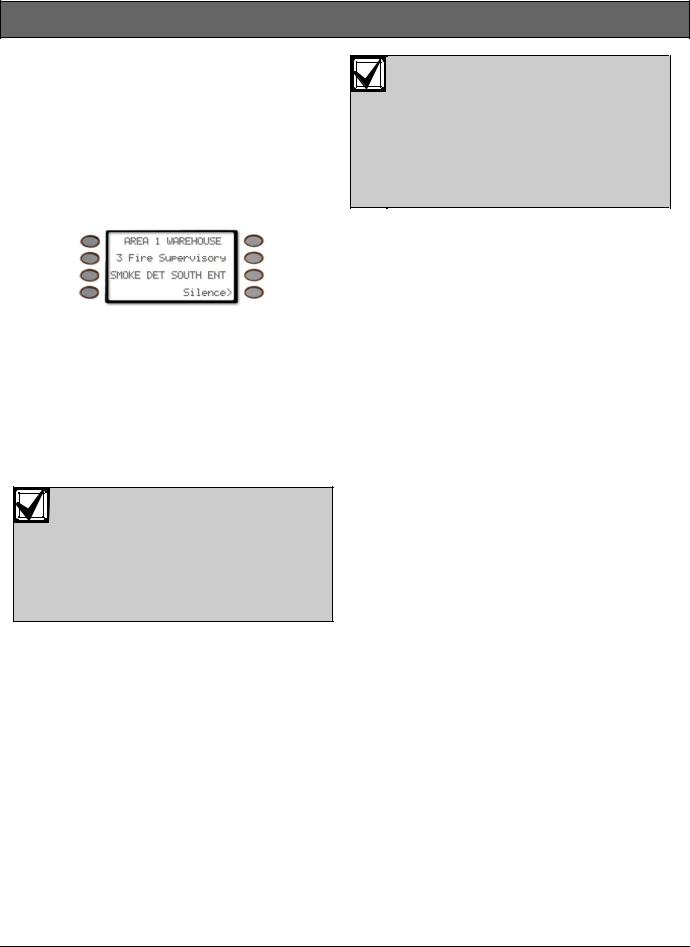
D1260/D1260B | Owner's Manual | Part I: Security system basics - Fire Trouble and Fire Supervisory Events
Fire Trouble and Fire Supervisory
Events
When a fire trouble or fire supervisory condition occurs, your keypad emits three warble tones, then a pause (repeatedly).
The system displays the number of fire points that are in a trouble or supervisory condition as well as the point text of the affected points.
Silencing Fire Trouble and Fire Supervisory conditions
Pressing COMMAND 4 or the Silence> soft key silences the conditions. In addition to this, entering a personal passcode with the proper authority level silences the condition and disarms the panel if it was armed. If you wish to review these cleared troubles, using COMMAND 40 can do this.
Some systems may be programmed to automatically re-sound the keypad’s trouble tone after a period of time if the fire trouble or fire supervisory condition remains. Consult your security company for further information.
Special Fire Trouble and Fire Supervisory
Display
If you silence the keypad or clear a trouble or supervisory condition for a Fire Point from the display and the fire point remains in trouble, Fire Trouble or Fire Supervisory appears in the keypad’s display. This remains in the display until the condition causing the trouble is cleared.
Some fire points, when tripped, will display FIRE TROUBLE for a preset amount of time. If no other fire activity is detected, this condition will automatically clear. If the condition remains or another fire detector is tripped, a fire alarm will occur.
Viewing Fire Trouble and Fire Supervisory conditions
After pressing COMMAND 4 or entering your passcode, the text of the fire point in trouble continues to automatically scroll through the display. Press View Points> soft key and then Next> soft key to scroll these displays manually if you wish. Events scroll in chronological order.
Non-Fire Trouble and Supervisory
Events
When a trouble event occurs, your keypad may be programmed to emit three warble tones, then a pause (repeatedly).
If the system was armed the keypad display shows the number of non-fire trouble events or non-fire supervisory events and then custom text for each activated point.
Silencing Non-Fire Trouble and Supervisory
Events
Pressing COMMAND 4 or the Silence> soft key silences the Trouble and/or non-fire Supervisory conditions. In addition to this, entering a personal passcode with the proper authority level silences a trouble and disarms the panel if it was armed. Press the View Points> soft key then the Next> soft key to scroll these displays manually. If you wish to review these cleared troubles, use COMMAND 40 to do this.
Bosch Security Systems | 12/15 | F01U036089-04 |
13 |
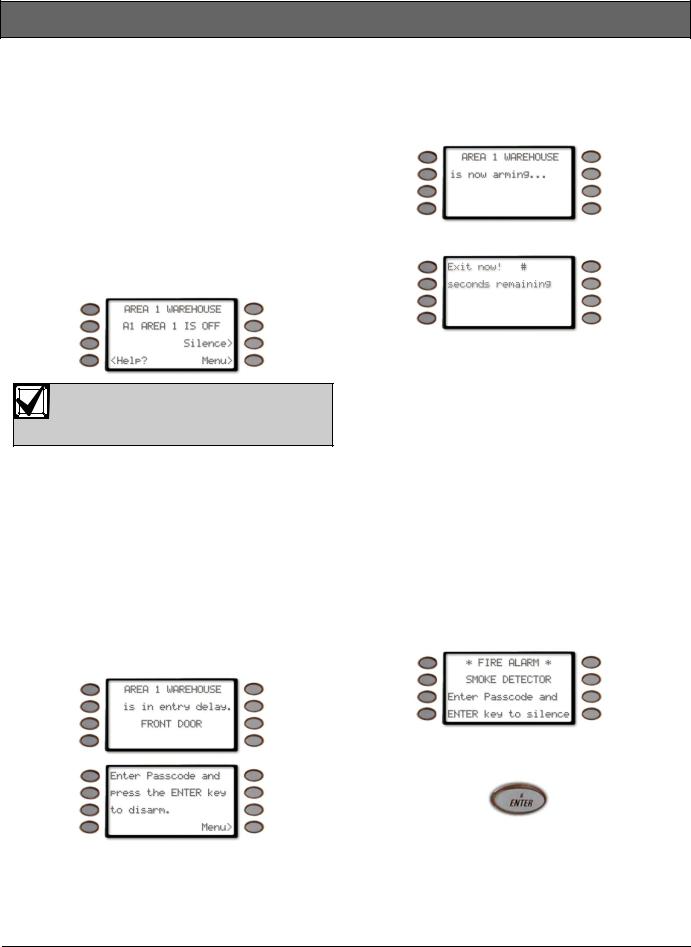
D1260/D1260B | Owner's Manual | Part I: Security system basics - Special System Trouble Display
Special System Trouble Display
These displays appear on all keypads in the system. See Standard Displays for a description of each system trouble display. Entering your passcode, COMMAND 4 or pressing the Silence> soft key will silence a system trouble tone, but the System Trouble display will not clear until the faulted condition is corrected.
A system trouble display begins by sounding a trouble tone and then three seconds later the specific System Trouble Display is shown, such as Service AC Fail.
Some system may be programmed to not initiate a trouble tone during these conditions.
Cleared Events Are Not Lost
If you clear the alarms and troubles from the display, you can still view all the events that occurred since the last time the system was armed by using COMMAND 40 (View Event Memory).
Entry Delay Tone and Display
When you enter an armed system through a point programmed for entry delay, the keypad emits a repeating warble tone and displays the following to remind you to turn off your security system.
Exit Delay Tone and Display
After you arm your system, the keypad emits a repeating beep tone, displays AREA 1 NAME TEXT is now arming… then
EXIT NOW! and counts down the exit delay time.
Keystroke Checking Tones
Valid Entry
If you press an appropriate key for the function or entry you desire, the keypad emits a muted beep tone, indicating it accepted your keystroke.
Invalid Entry
A flat buzz tone sounds when you perform a function that is not allowed or when the keypad has no information to display.
Silencing an Alarm
The audible alarm sounds for a specific period of time before it automatically shuts off. If an alarm occurs and you want to silence the siren before the time expires, simply enter your personal passcode and press ENTER.
To SILENCE an alarm:
Enter your passcode and press ENTER
.
If you fail to turn off the security system before the entry delay time expires, it may sound the burglary tone and may also send an alarm report to your security company.
14 |
Bosch Security Systems | 12/15 | F01U036089-04 |
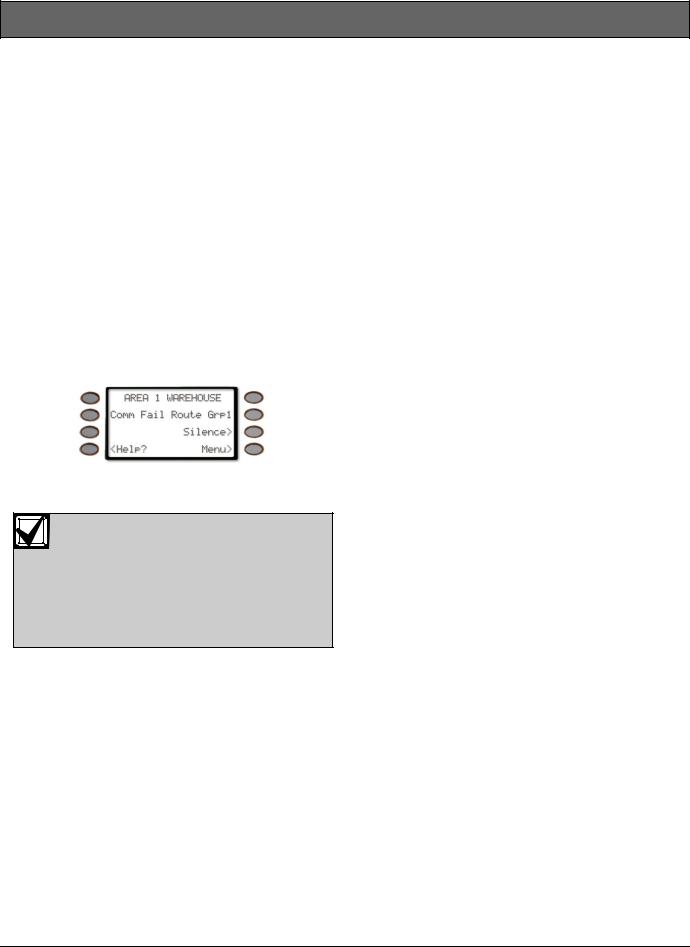
D1260/D1260B | Owner's Manual | Part I: Security system basics - Silencing an Alarm
How Your System Reports Alarms
Your security system may be programmed to automatically disconnect your telephones when sending reports to your security company. Once the report is completed, your security system returns the telephones to normal operation (check with your security company). Other methods of communicating alarm conditions are also available. Please consult your security company for services available in your area.
Your system makes repeated attempts to send reports to your security company.
In the event your security system fails to communicate, the keypad sounds a Trouble Tone and displays AREA 1 WAREHOUSE Comm Fail Route Grp1 (where the Route Group can be 1, 2, 3, or 4):
Notify your security company of the communications failure.
If your system uses telephone lines as its means of communication and telephone service is interrupted, your security system cannot send reports to your security company unless it has an alternate means of transmitting them.
Bosch Security Systems | 12/15 | F01U036089-04 |
15 |
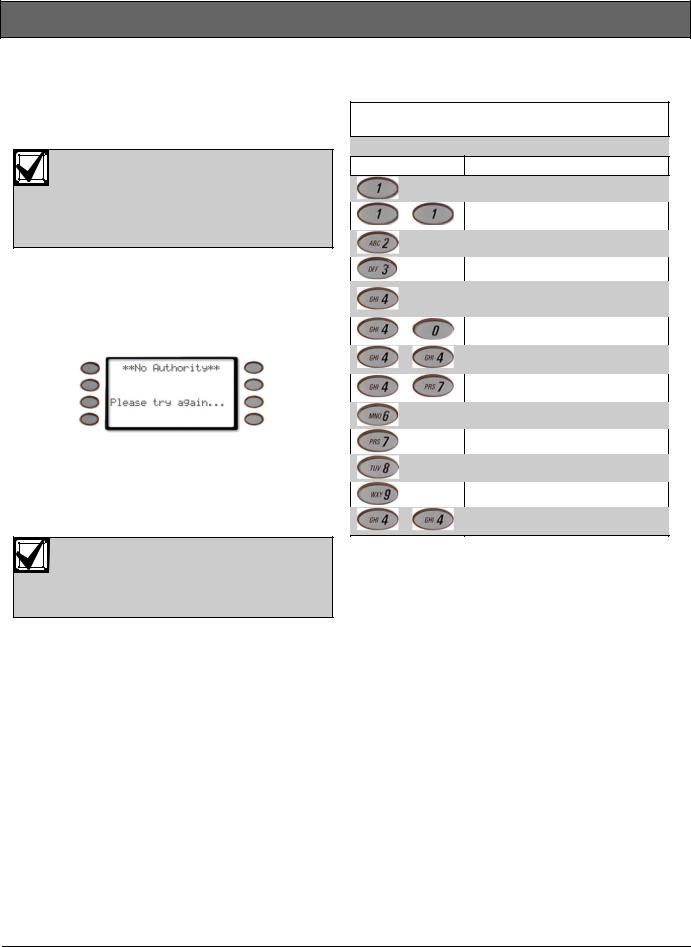
D1260/D1260B | Owner's Manual | Part II: System Commands - Silencing an Alarm
Part II: System Commands
Below is a summary of the commands covered in this section.
Some of these functions may not be available in your system. Please consult your security company to determine which commands have been made available to you.
If you attempt to enter a function that’s not available or if the function is available in the system but your passcode is not authorized to perform the function, then **No Authority** will display on the Keypad.
Press the COMMAND key and then the one or two digits shown in the table below to perform the function. When you use a command to perform a function, the displays in the function list below do not appear at your keypad.
Some commands listed below may not be available. Contact your security company for more information.
Table 2: Keypad Commands
COMMAND Function
Master Arm
Master Arm Instant
+
Perimeter Instant
Perimeter Delay
Silence Trouble Sounder & Clear
Trouble Display
View Memory
+
Walk Test
+
Reset Sensors
+
Watch Mode
Special Alert
Perimeter Partial
Special Alert
Walk Test
+
16 |
Bosch Security Systems | 12/15 | F01U036089-04 |
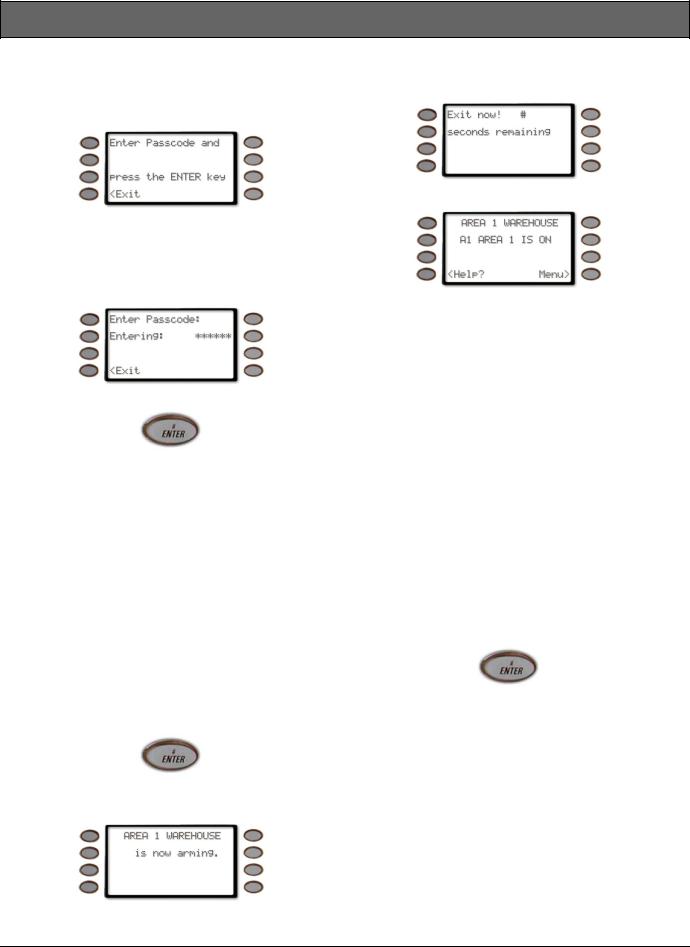
D1260/D1260B | Owner's Manual | Part II: System Commands - Entering a Passcode
Entering a Passcode |
and the exit delay tone begins. After exit |
1. The display may prompt you to enter your |
delay time expires, |
|
|
passcode. |
|
the display changes to idle armed text.
2.The passcode is shown as asterisks (*) when entered and advance from the right side of the display to the left until all passcode digits (from a minimum of 3 to a maximum of six) are entered.
3. Press ENTER.
Turning On the System (Arming)
Your security system can be turned on (armed) in many different ways, depending on the arming command used. Arming Commands are those commands used to turn on the system. The most basic arming command is to arm the entire system. The simplest way to arm your system is to enter your personal passcode or press [COMMAND] [1].
There are several other arming commands to turn on the system. These are described later in this manual.
To Turn Your Security System On (Arm):
1.Enter your passcode and press ENTER.
2.The keypad briefly displays AREA 1 NAME TEXT is now arming…,
Turning Off the System (Disarming)
Entering your personal passcode turns off your security system. When the system is turned on, you must enter through a designated entry door to prevent an instant alarm condition. Opening the door starts entry delay time and the Keypad emits a pulsing “beep” tone to remind you to turn off the system. Enter your passcode before the delay time expires and the system will turn off.
If you enter through the wrong door or fail to disarm before the entry delay time expires, you will cause an alarm.
If this happens, silence the alarm (by entering your personal passcode and pressing ENTER) and call your security company to let them know that it is not an emergency situation.
Bosch Security Systems | 12/15 | F01U036089-04 |
17 |

D1260/D1260B | Owner's Manual | Part II: System Commands - Turning On the System (Arming) With a Duress Passcode
To Turn Your Security System Off (Disarm):
1.Enter your passcode and press ENTER.
2.You must press the ENTER key within 5 seconds of entering your passcode, or the passcode entry will be invalid.
3.The display returns to idle disarmed text.
Turning On the System (Arming) With a
Duress Passcode
Your passcode may have a special duress feature that is simply your personal passcode with its last digit increased by 1 or 2.
If an intruder demands that you arm or disarm the security system, you can use your duress passcode. The duress passcode arms or disarms the system and sends an alarm report to your security company. There is no alarm tone or visual indication at the premises that the report is sent. Check with your security company before attempting to use this feature.
2.The display shows Check Area #.
3.One of the messages below may display in place of Check Area #.
Indicates the system is programmed not to arm with particular points faulted (doors or windows open).
Indicates that the system’s number of allowable bypassed points has been reached. Your system’s maximum number of bypassed and/or force armed points is set by your security company. Check with them to learn this number.
Turning On the System (Arming) With Doors or Windows Open
If a protected door or window is open, you may have the option of “force arming” with that point faulted. Faulted points (opened doors or windows) that are force armed are not included in the system. The remaining points arm normally.
Force armed points either return to normal operation after you turn off your system or return to normal when the door or window is closed. Your system might not offer force arming or it may be restricted to specific points. Contact your security company for more information.
1.Use your passcode or an arming function to start the arming process.
Indicates that more than the number of allowable points are faulted. Bypassed points are counted as faulted. Your system’s maximum number of bypassed and/or force armed points is set by your security company. Check with them to learn this number.
4.The display shows AREA 1 WAREHOUSE Not Ready to Arm.
18 |
Bosch Security Systems | 12/15 | F01U036089-04 |
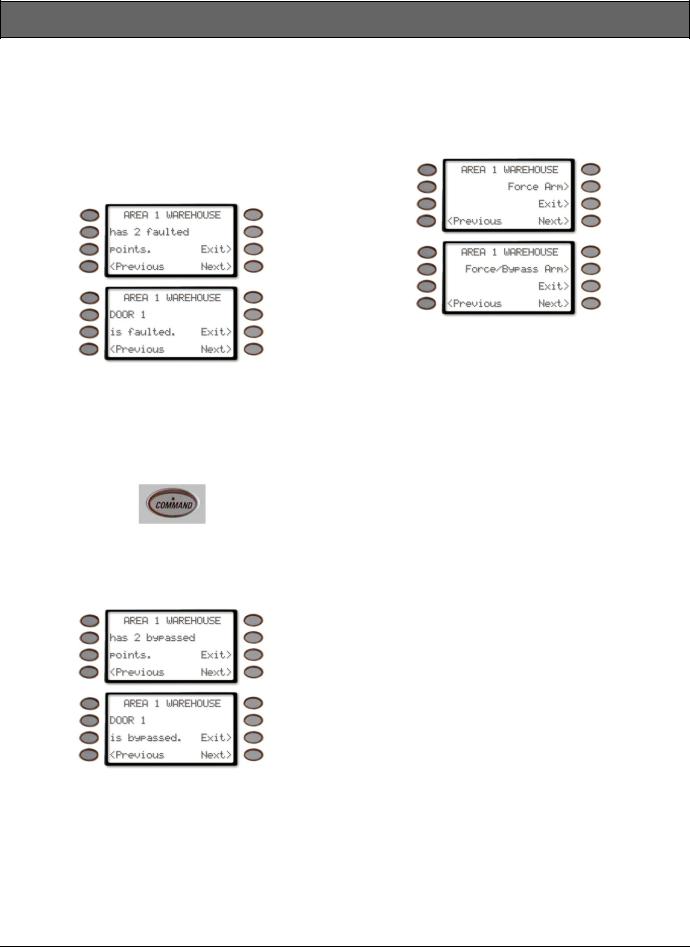
D1260/D1260B | Owner's Manual | Part II: System Commands - Turning On the System (Arming) With Doors
or Windows Open
5.Pressing the View Points> soft key will show the specifics for any points that are faulted, if any, and bypassed, if any.
Faulted points are displayed first then bypassed points.
6.The display changes to show the number of faulted points in the area.
Press Next> soft key repeatedly to scroll through the point text for each faulted point.
If you do not want to go through the list of faulted points and want to go directly to the
Force Arm> soft key or Force Bypass> soft key, press the COMMAND button.
7.Once the last faulted point is displayed, pressing the Next> soft key will start displaying a summary and then specifics of any bypassed points.
8.Once the last bypassed point is displayed, the display will change to show the soft key to either force arm the faulted points (Force Arm>) or force arm the faulted/bypassed points (Force/Bypass Arm>).
9.Press the appropriate soft key to arm your system with the faulted/bypassed points removed from service.
Bosch Security Systems | 12/15 | F01U036089-04 |
19 |

D1260/D1260B | Owner's Manual | Part II: System Commands - MASTER ARM ? (COMMAND + 1)
MASTER ARM ? (COMMAND + 1)
Description
Use this function to turn on the entire system, both perimeter and interior. When you turn on the system, the display shows how many seconds of exit delay time you have to exit the protected area. You should leave before exit delay time expires.
Leaving after exit delay has expired will cause the entry delay to start. You may also cause an alarm on an interior device. Enter your personal passcode to disarm the system.
This function may be used by your cleaning service, a serviceman, or others who need to turn on your system when they leave.
Using Master Arm:
Using the COMMAND +1 shortcut will only arm the area where the keypad has been assigned. Example, if the D1260 is assigned to Area 1, only Area 1 will be armed when COMMAND + 1 is pressed.
1.The display shows disarmed idle text.
2.Press the COMMAND key.
3.The display shows *System Command*.
4.Press the 1 key
5.If your system is programmed to require a passcode when performing a COMMAND 1, the display prompts you to enter your passcode.
The passcode is shown as asterisks (*).
6.If the passcode has valid authority for this command, the display shows Exit now # (# = exit delay time remaining) seconds remaining.
After the exit delay time expires, the display changes to idle armed text.
7.To disarm your security system, enter your personal passcode and press ENTER.
Master Arming all Areas
If you prefer, you may use the Master Arm ?> command in the Command Menu to initiate this function which will arm all available areas according to your authority level.
1.The display shows disarmed idle text.
2.Press the MENU> soft key to enter the Command Menu,
3.then press NEXT> soft key repeatedly
20 |
Bosch Security Systems | 12/15 | F01U036089-04 |
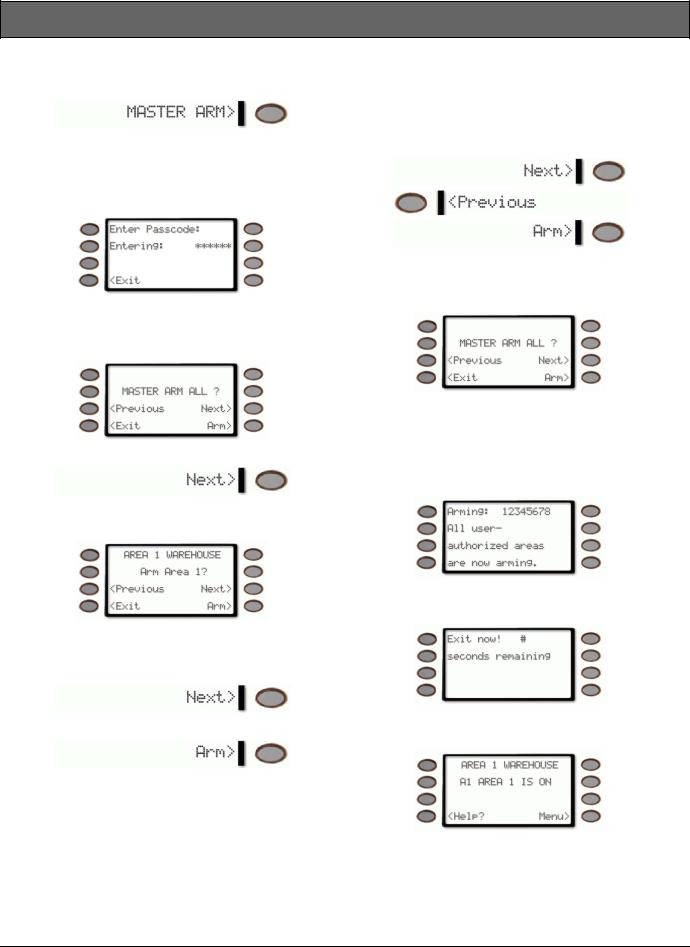
D1260/D1260B | Owner's Manual | Part II: System Commands - MASTER ARM ? (COMMAND + 1)
4.until you reach the MASTER ARM ?> prompt. Press the soft key.
5.The display may prompt you to enter your passcode.
The passcode is shown as asterisks (*) when entered.
6.If there is more than one area that is set up, the option is given to arm all of them with MASTER ARM ALL ?
or by pressing the Next> soft key…
to view each unarmed area and optionally arm each one.
7.To arm a selected area, press Next> until the desired area appears (Area name text along with Arm Area # ?).
8.Then press Arm>
9.The next available area will appear with the option to arm it.
Every time the Next>,<Previous or Arm> soft keys are pressed, the display scrolls to the next unarmed area.
10.To arm all available areas, press the Arm> soft key when the display reads Master Arm All ?
11.The display changes to show that all areas are arming.
Depending on what areas are armed or areas that you have authority, 12345678 may or may not appear.
12.then displays Exit now # (# = exit delay time remaining).
After the exit delay time expires, the display changes to idle armed text.
13.To disarm your security system, enter your personal passcode and press ENTER.
Bosch Security Systems | 12/15 | F01U036089-04 |
21 |
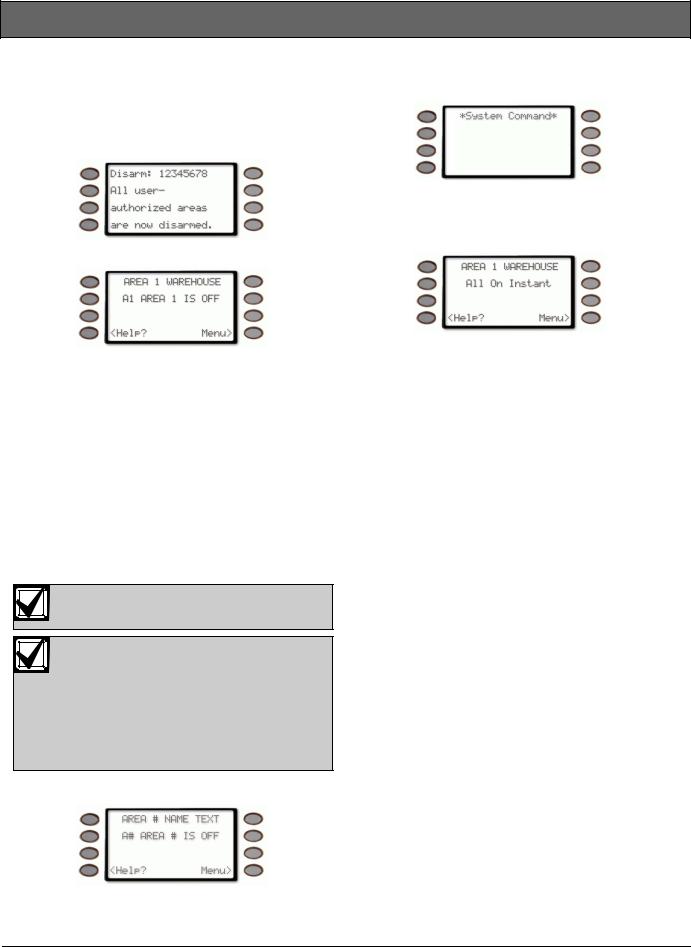
D1260/D1260B | Owner's Manual | Part II: System Commands -
14. The display changes to show that all the |
2. |
Press the COMMAND key. The display shows |
areas are disarmed. |
|
*System Command*. |
Depending on what areas are armed or areas |
|
|
that you have authority, 12345678 may or |
|
|
may not appear. |
|
|
|
3. |
Press the 1 key. Now press the 1 key again. |
|
4. |
The keypad display shows AREA 1 |
The display returns to idle text. |
|
WAREHOUSE All On Instant. |
|
|
5. To disarm your security system, enter your personal passcode and press ENTER.
MASTER ARM INST ? (COMMAND + 1 + 1)
Use this function to turn on a single area, both perimeter and interior without delays. When entering COMMAND 11, remember that the second 1 must be pressed within 2 seconds after pressing the first 1.
The menu entry MASTER ARM INST> is different in that it allows all or selected areas to be armed instantly.
COMMAND 11 does not comply with
SIA CP-01 Standard.
Using the COMMAND + 1 + 1 shortcut will only instantly arm the area where the keypad has been assigned. Example, if the D1260 is assigned to Area 1, only Area 1 will be armed when COMMAND + 1 + 1 is pressed.
1. The display shows disarmed idle text.
22 |
Bosch Security Systems | 12/15 | F01U036089-04 |
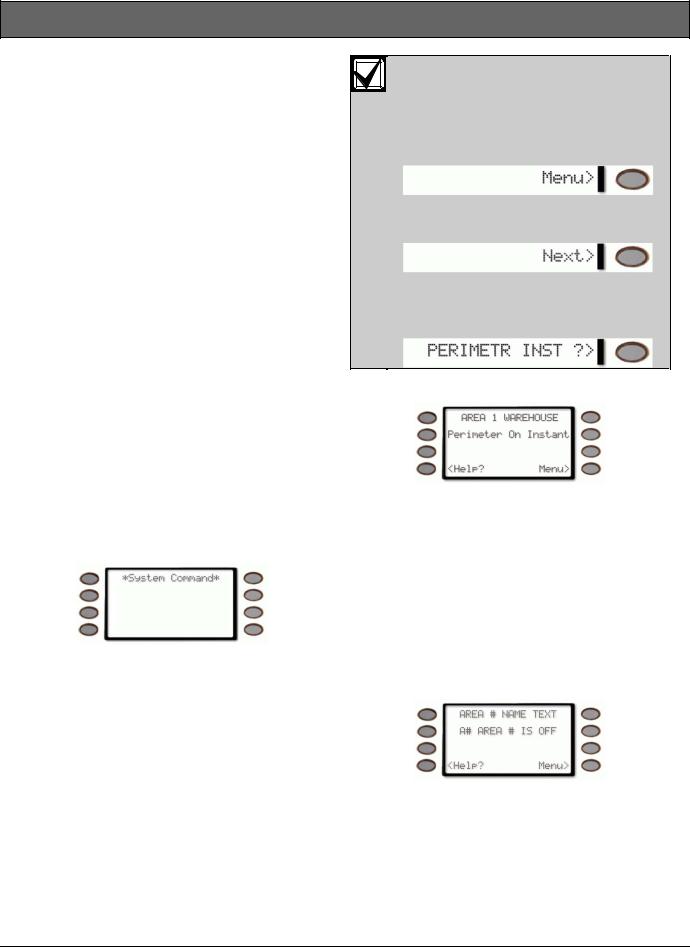
D1260/D1260B | Owner's Manual | Part II: System Commands - PERIMETR INST (COMMAND + 2)
PERIMETR INST (COMMAND + 2)
Turn On the Perimeter With No Delays
Description
Use this function to turn on only the perimeter of your building, leaving the interior of the building disarmed. This function allows no exit or entry delay time through the perimeter, including the designated exit delay door.
This function is useful in residential systems when everyone is home and ready to retire for the evening. You can have the security of an armed perimeter, yet move freely throughout the interior of the premises.
It is also useful in commercial systems when you are working before or after business hours and wish to have the perimeter armed. Remember there are no entry or exit delays when you use this function. You must disarm (turn off) the system to enter or exit the premises.
Using Perimeter Inst:
1.Interior points are not armed with this command and may remain faulted while arming with COMMAND 2.
2.Press the COMMAND key.
The display shows *System Command*.
3.Press the 2 key.
If you prefer, you may use the Command Menu in place of steps 2 and 3 to initiate this function.
Press the MENU> soft key to enter the Command Menu,
then press NEXT> soft key repeatedly.
until you reach the PERIMETR INST ?> prompt, then press the adjacent soft key.
4.The display shows Perimeter On Instant.
After arming the perimeter without delays, you cannot enter or exit the premises without disarming the system. Opening a perimeter door before disarming will generate an alarm. If this happens, silence the alarm by turning off your system and call your security company to let them know that it is not an emergency situation.
5.To disarm your security system, enter your personal passcode and press ENTER.
The display then returns to idle text.
Bosch Security Systems | 12/15 | F01U036089-04 |
23 |
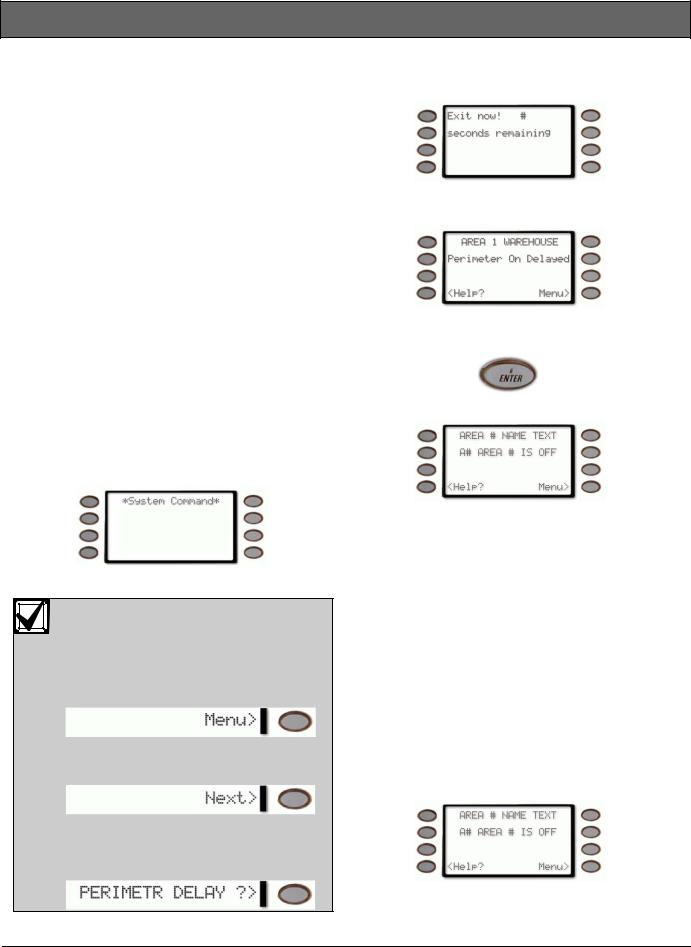
D1260/D1260B | Owner's Manual | Part II: System Commands - PERIMETR DELAY ? (COMMAND + 3)
PERIMETR DELAY ? (COMMAND + 3)
Turn On the Perimeter With Delays
Description
In residential systems this function allows you to only arm the perimeter and exit through a door programmed for exit delay. The interior of the building remains disarmed. People or pets are free to move throughout the interior of the premises.
This function is also useful in commercial systems when you are working before or after business hours and wish to have the perimeter armed. Other system users can enter through doors programmed for entry delay, which will start the entry delay sounder and countdown.
Using Perimeter Delay
1.Interior points are not armed with this command and may remain faulted while arming with COMMAND 3.
2.Press the COMMAND key.
The display shows *System Command*.
4.The display shows Exit now! # (# = exit delay time remaining).
After the exit delay expires, Perimeter On Delayed is displayed.
5.To disarm your security system, enter your personal passcode and press ENTER.
The display then returns to idle text.
3. Press the 3 key.
If you prefer, you may use the Command Menu in place of steps 2 and 3 to initiate this function.
Press the MENU> soft key to enter the Command Menu,
then press NEXT> soft key repeatedly.
until you reach the PERIMETR DELAY ?> prompt, then press the adjacent soft key.
Silence the Trouble Sounder & Clear Trouble Display (COMMAND + 4)
Description
Use COMMAND 4 to silence the trouble sounder during system events. This command also clears system messages from the display. If an alarm has occurred and was silenced, the *ALARM SILENCED* display will continue to scroll to remind you that cleared events can be seen with the View Memory function (refer to VIEW MEMORY ? (COMMAND + 4 + 0) on page 25).
Using COMMAND 4:
1. The display shows disarmed idle text.
24 |
Bosch Security Systems | 12/15 | F01U036089-04 |
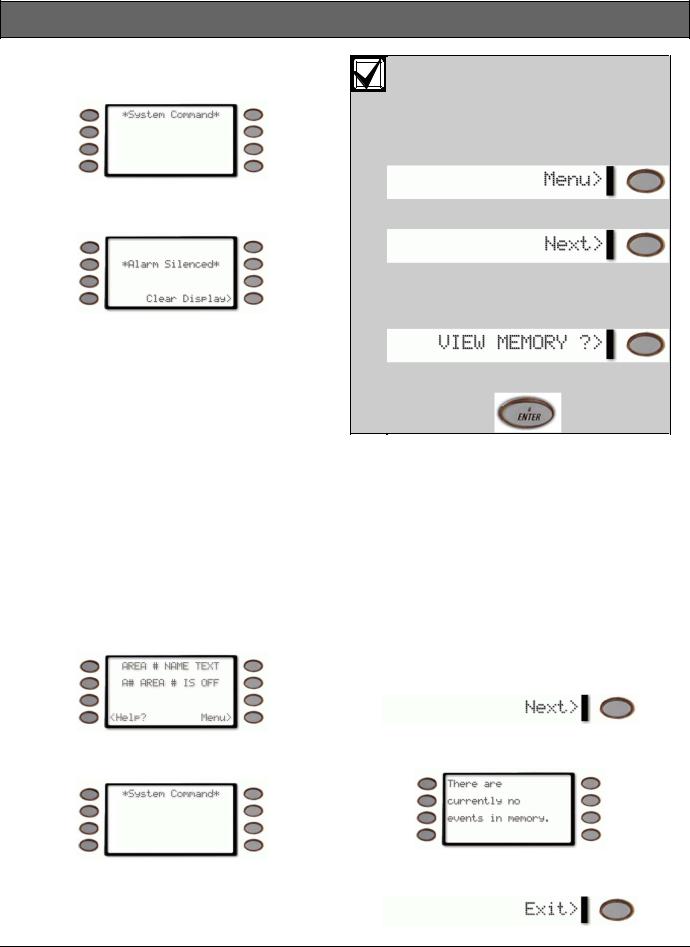
D1260/D1260B | Owner's Manual | Part II: System Commands - VIEW MEMORY ? (COMMAND + 4 + 0)
Press the COMMAND key. The display shows
*System Command*.
2.Press the 4 key.
3.The Keypad sounder is silenced.
VIEW MEMORY ? (COMMAND + 4 + 0)
View Event Memory
Description
Your system stores events that occurred since the last time memory was cleared. Use COMMAND 40 to view Event Memory.
Event Memory allows you or a service technician to review events after they are cleared from the keypad’s display. *ALARM SILENCED* will continue to scroll to remind you that events are stored in Event Memory.
Each time you turn on the system on, the Event Memory is erased and the ALARM SILENCED message is cleared.
Using View Memory:
1.The display shows disarmed idle text.
2.Press the COMMAND key. The display shows
*System Command*.
3.Press the 4 key and then the 0 key.
If you prefer, you may use the Command Menu in place of steps 2 and 3 to initiate this function.
Press the MENU> soft key to enter the Command Menu.
Press NEXT> soft key repeatedly.
When you reach the VIEW MEMORY ?> prompt, press its adjacent soft key.
Press ENTER.
4.Your system displays event summary lines and point text in this order:
a.fire alarm summary line
b.point text for each fire alarm event
c.alarm summary line
d.point text for each alarm event
e.fire trouble summary line
f.point text for each fire trouble event
g.trouble summary line
h.point text for each trouble event.
5.Press NEXT> to scroll through the events.
If there are no events to view, There are currently no events in memory displays.
6.You can return to idle text at any time by pressing Exit> soft key.
Bosch Security Systems | 12/15 | F01U036089-04 |
25 |
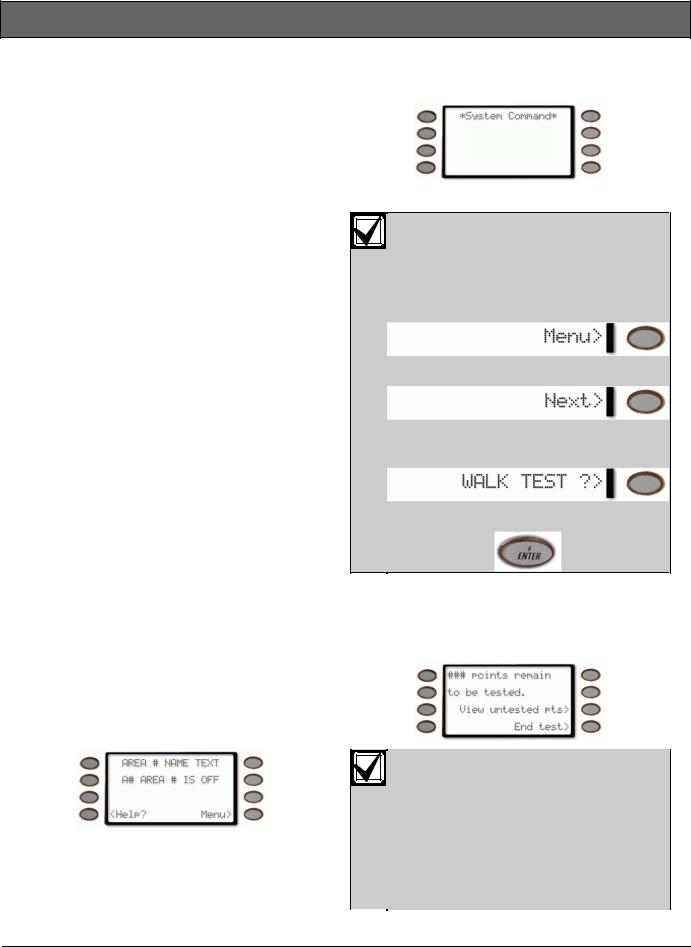
D1260/D1260B | Owner's Manual | Part II: System Commands - WALK TEST ? (COMMAND + 4 + 4)
WALK TEST ? (COMMAND + 4 + 4)
Walk Test
Description
Use this function to test keypads, detection devices, and sounders (both interior and exterior) to be certain they function properly. You can review untested points at your keypad to help pinpoint any problems.
You cannot arm your system while in the walk test mode, and no alarm reports are sent to your security company unless a 24-hour point is activated (such as fire or panic). A Walk Test Start Report may be programmed to be sent to your security company.
Upon initiation, the walk test will test the burglary bell pattern on the bell output and ring the keypad burglary bell for 2 seconds. The AC will be disabled for 4 minutes in order to test the system’s battery power. If the battery cannot maintain the system for the 4-minute period, the keypad will appear to go dead. If your keypads are programmed to be supervised, the main alarm panel will beep intermittently during this 4- minute period. If this happens, contact your security company. At the end of the 4-minute period, AC is returned to the system and the panel restores. To test individual detection devices, simply activate sensors and open protected doors and windows one-at-a-time. As each detection device is faulted, the Keypad emits a brief tone and the display indicates for 60 seconds that the point has been tested. This verifies that each detection device is working properly.
Using Walk Test:
1. The display shows disarmed idle text.
2.Press the COMMAND key. The display shows
*System Command*.
3.Press the 4 key and then the 4 key.
If you prefer, you may use the Command Menu in place of steps 2 and 3 to initiate this function.
Press the MENU> soft key to enter the Command Menu.
Press NEXT> soft key repeatedly.
When you reach the WALK TEST ?> prompt, press its adjacent soft key.
Press ENTER.
4.The burglary bell sounds for 2 seconds. When the display shows ### points remain to be tested (### is the number of points) you can begin.
If you know the point number, you can enter it by pressing its number key and then the ENTER key
The display will change to show the point that was entered. If the point is invalid the message “Invalid Point” or “This is not a valid walk point” appears.
26 |
Bosch Security Systems | 12/15 | F01U036089-04 |
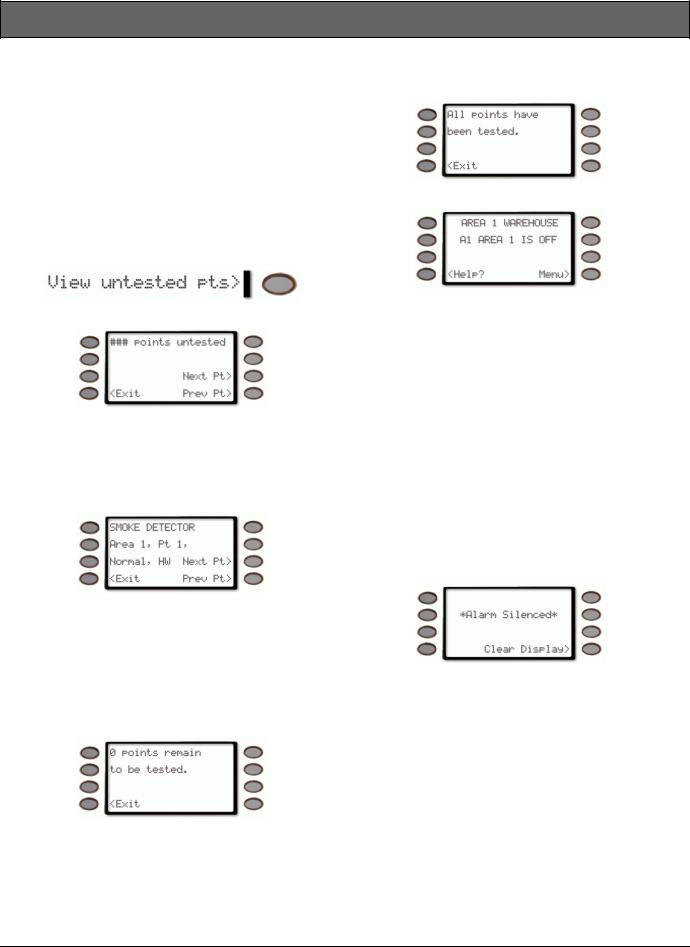
D1260/D1260B | Owner's Manual | Part II: System Commands - RESET SENSORS ? (COMMAND + 4 + 7)
Test each point by first opening and then closing the door or window or other detection device.
Check the display after testing each point. For interior points, walking past the device once is sufficient. If any point does not test correctly, contact your security company for service.
5.During the Walk Test you may want to see the points that remain untested by pressing the
View untested pts> soft key.
The display shows ### points untested.
Press the Next Pt> or Prev Pt> soft keys to see information about specific points that have not yet been tested.
6.Move through this list by pressing the Next Pt> soft key.
The display changes to show the information for that point.
Press the Exit> soft key to return to the ###
points remain to be tested screen before continuing with the walk test.
7.When all points have been tested, 0 points remain to be tested is displayed.
Press the <Exit soft key.
The display momentarily shows All points have been tested.
The displays then shows idle text.
RESET SENSORS ? (COMMAND + 4 + 7)
Reset Sensors
Description
Detection devices, such as smoke detectors and shock sensors, must be reset after being activated. This function momentarily removes power from these sensors to reset them.
It also clears point information from the display, leaving the *ALARM SILENCED* message in the display as a reminder that the View Memory function can be used to view the cleared point information.
To clear the event memory and remove the *Alarm Silenced* message from the display, press the Clear Display> soft key.
Bosch Security Systems | 12/15 | F01U036089-04 |
27 |
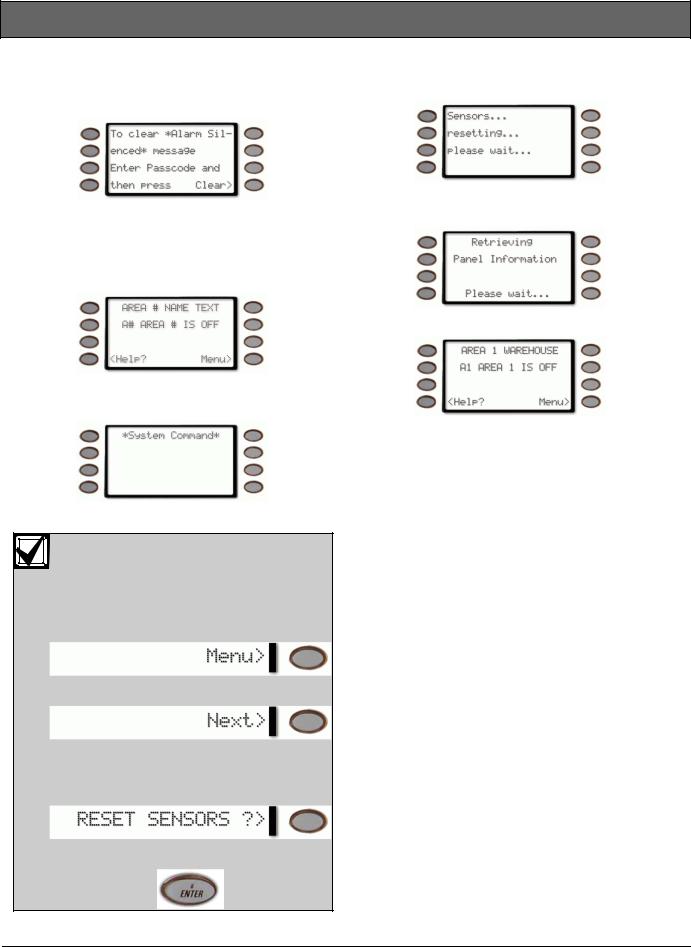
D1260/D1260B | Owner's Manual | Part II: System Commands - RESET SENSORS ? (COMMAND + 4 + 7)
The display will show the instructions for clearing the message. Enter a valid passcode and press the Clear> soft key.
Arming the system will also clear the display and the event memory.
Using Reset Sensors:
1.The display shows disarmed idle text.
2.Press the COMMAND key. The display shows
*System Command*.
3.Press the 4 key, followed by the 7 key.
If you prefer, you may use the Command Menu in place of steps 2 and 3 to initiate this function.
Press the MENU> soft key to enter the Command Menu.
Press NEXT> soft key repeatedly.
When you reach the RESET SENSORS ?> prompt, press its adjacent soft key.
4.The display shows for approximately 15 to 20 seconds.
The display then shows retrieving the panel information.
The display then returns to show idle text.
If you enter this function and the detector or sensor resets momentarily, but then returns to a faulted condition, the conditions causing the activation may still be present or the detector may be faulty. Check to be certain that there is no smoke, fire, or other danger present. If you can’t reset the detector or sensor contact your security company.
Press ENTER.
28 |
Bosch Security Systems | 12/15 | F01U036089-04 |

D1260/D1260B | Owner's Manual | Part II: System Commands - WATCH MODE ? (COMMAND + 6)
WATCH MODE ? (COMMAND + 6)
Watch Mode
Description
With your security system disarmed, you can use watch mode to monitor some points. Each time some points are faulted (door or window is opened) the keypad chimes once and displays the point text for 60 seconds. No alarms are generated by this mode except 24-hour alarms (fire, panic, etc.).
When the keypad’s keypad lighting is on, the keypad does not chime. The keys light for 20 seconds whenever you press a key.
Use this function in residential systems to monitor entries or exits in your home. In commercial systems it can serve as a door chime to alert you when a customer or delivery person enters your business.
Contact your security company to find out which points are watch points and whether or not your system automatically turns the Watch Mode on whenever you disarm.
Entering Watch Mode:
1.The display shows disarmed idle text.
Press the COMMAND key. The display shows
*System Command*.
2.Press the 6 key.
If you prefer, you may use the Command Menu in place of steps 2 and 3 to initiate this function.
Press the MENU> soft key to enter the Command Menu.
Press NEXT> soft key repeatedly.
When you reach the WATCH MODE ?> prompt, press its adjacent soft key.
Press ENTER.
3.The display briefly shows Watch Mode is now on.
The display returns to show idle text.
Bosch Security Systems | 12/15 | F01U036089-04 |
29 |
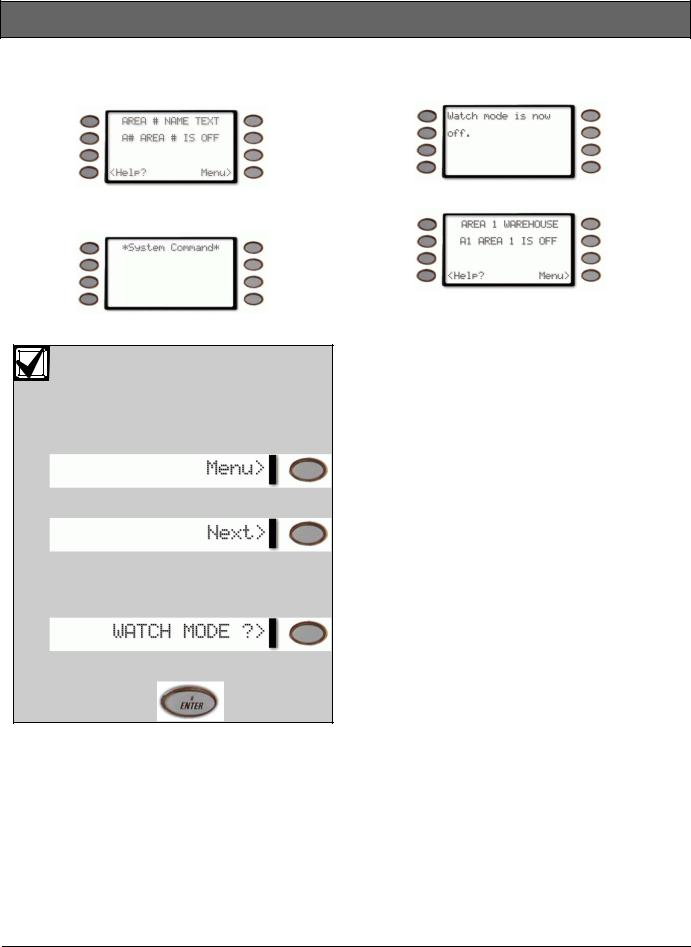
D1260/D1260B | Owner's Manual | Part II: System Commands -
Exiting Watch Mode: |
3. The display briefly shows Watch Mode is now |
1. The display shows disarmed idle text. |
off. |
|
Press the COMMAND key. The display shows
*System Command*.
2. Press the 6 key.
If you prefer, you may use the Command Menu in place of steps 2 and 3 to initiate this function.
Press the MENU> soft key to enter the Command Menu.
Press NEXT> soft key repeatedly.
When you reach the WATCH MODE ?> prompt, press its adjacent soft key.
The display returns to show idle text.
Press ENTER.
30 |
Bosch Security Systems | 12/15 | F01U036089-04 |
